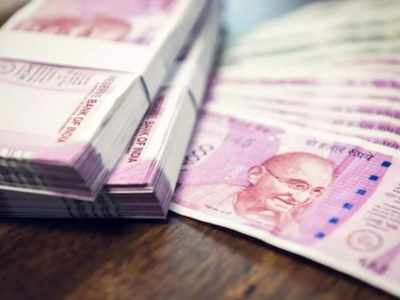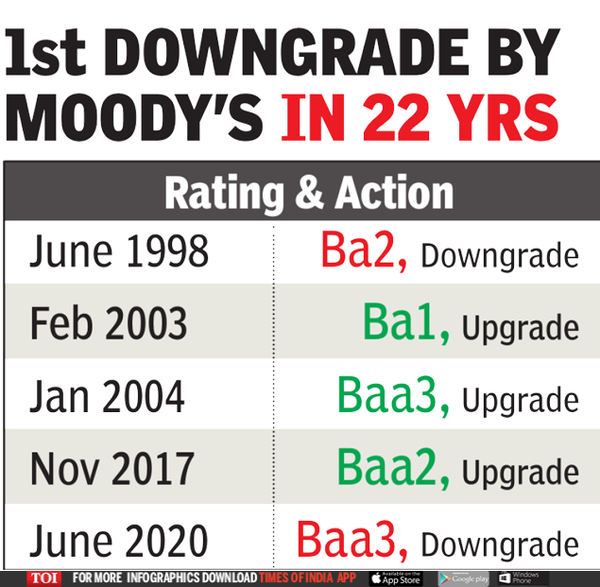- News
- Business News
- India Business News
- Moody’s downgrades India rating for 1st time in 22 yrs
Trending
This story is from June 2, 2020
Moody’s downgrades India rating for 1st time in 22 yrs
Global ratings agency Moody’s Investors Service on Monday downgraded India’s sovereign rating to the lowest investment grade, saying the country’s policymaking institutions would be challenged in enacting and implementing policies which mitigate the risks of a sustained period of low growth, significant further deterioration in the government fiscal position.

Representative image
NEW DELHI: Global ratings agency Moody’s Investors Service on Monday downgraded India’s sovereign rating to the lowest investment grade, saying the country’s policy making institutions would be challenged in enacting and implementing policies which mitigate the risks of a sustained period of low growth, significant further deterioration in the government fiscal position and stress in the financial sector.
The downgrade by Moody’s comes nearly 22 years after it lowered India’s rating on June 19, 1998 in the aftermath of the country’s nuclear tests. The lowering of the rating — from Baa2 to Baa3 — brings it on a par with S&P and Fitch which rate India at BBB (minus), the lowest investment grade.

The downgrade comes against the deterioration in the country’s growth prospects as the national lockdown unveiled to stem the spread of the Covid-19 pandemic has stalled economic activity. This has also choked revenues, including those from GST prompting the government to raise its market borrowing sharply which economists say will widen its fiscal deficit to around 5.5% of gross domestic product. Moody’s action is likely to put pressure on the rupee, raise borrowing costs and dampen investor sentiment which is already stretched due to the impact of the pandemic on all major global economies.
“Slow reform momentum and constrained policy effectiveness have contributed to a prolonged period of slow growth, compared to India's potential, that started before the pandemic and that Moody's expects will continue well beyond it,” Moody’s said.
The agency said GDP growth has declined from a high of 8.3% in fiscal 2016 (ending March 2017) to 4.2% in fiscal 2019 and expects India's GDP to contract by 4.0% in fiscal 2020 due to the shock from the coronavirus pandemic and related lockdown measures, followed by 8.7% growth in fiscal 2021 and closer to 6.0% thereafter.
It said that thereafter and over the longer term, growth rates are likely to be materially lower than in the past, due to persistent weak private sector investment, tepid job creation and an impaired financial system. The agency said that in turn, a prolonged period of slower growth may dampen the pace of improvements in living standards that would help support sustained higher investment growth and consumption.
“While the government responded to the growth slowdown prior to the coronavirus outbreak with a series of measures aimed at stimulating domestic demand, and recently announced a support package aimed at supporting India's most vulnerable households and small businesses, Moody's does not expect that these measures will durably restore real GDP growth to rates around 8%, which had seemed within reach just a few years ago,” the statement said.
The government has unveiled a series of measures to tackle the impact of the economy as well as announced reform steps to build the foundation for robust growth. “While achieving the objectives laid out in these announcements would be credit positive, challenges with implementation of previous reforms suggest that the benefits to medium-term growth will likely be less than intended,” Moody’s said.
It said that lower real and nominal GDP growth over the medium term will diminish the government's ability to reduce its debt burden, after a significant rise as a result of the coronavirus economic shock. A mixed track record on implementation of revenue-raising measures lowers the prospects of fiscal policy-driven budget consolidation, amplifying a long-standing weakness in India's credit profile, the agency added.
“Measures to improve India's fiscal strength, which were at the heart of the government's policy framework a few years ago, have underwhelmed. Fiscal performance in recent years has been weaker than expected, with fiscal deficit targets consistently missed and a persistent lack of clarity on how medium-term fiscal consolidation objectives would be achieved. Rather than beginning to fall, the debt burden remained at around 70% of GDP,” Moody’s said.
“Overall, with very limited room for outright fiscal consolidation, the outlook for India's debt burden will depend on trends in nominal GDP growth and is unlikely to decline unless growth accelerates markedly and sustainably above 10%,” it said.
Moody’s retained the outlook on India’s rating at negative saying it reflects mutually-reinforcing downside risks from potentially deeper stresses in the economy and financial system that could lead to a more severe and prolonged erosion in fiscal strength than the agency currently projects.
The downgrade by Moody’s comes nearly 22 years after it lowered India’s rating on June 19, 1998 in the aftermath of the country’s nuclear tests. The lowering of the rating — from Baa2 to Baa3 — brings it on a par with S&P and Fitch which rate India at BBB (minus), the lowest investment grade.

The downgrade comes against the deterioration in the country’s growth prospects as the national lockdown unveiled to stem the spread of the Covid-19 pandemic has stalled economic activity. This has also choked revenues, including those from GST prompting the government to raise its market borrowing sharply which economists say will widen its fiscal deficit to around 5.5% of gross domestic product. Moody’s action is likely to put pressure on the rupee, raise borrowing costs and dampen investor sentiment which is already stretched due to the impact of the pandemic on all major global economies.
“While today's action is taken in the context of the coronavirus pandemic, it was not driven by the impact of the pandemic. Rather, the pandemic amplifies vulnerabilities in India's credit profile that were present and building prior to the shock, and which motivated the assignment of a negative outlook last year,” the agency said.
“Slow reform momentum and constrained policy effectiveness have contributed to a prolonged period of slow growth, compared to India's potential, that started before the pandemic and that Moody's expects will continue well beyond it,” Moody’s said.
The agency said GDP growth has declined from a high of 8.3% in fiscal 2016 (ending March 2017) to 4.2% in fiscal 2019 and expects India's GDP to contract by 4.0% in fiscal 2020 due to the shock from the coronavirus pandemic and related lockdown measures, followed by 8.7% growth in fiscal 2021 and closer to 6.0% thereafter.
It said that thereafter and over the longer term, growth rates are likely to be materially lower than in the past, due to persistent weak private sector investment, tepid job creation and an impaired financial system. The agency said that in turn, a prolonged period of slower growth may dampen the pace of improvements in living standards that would help support sustained higher investment growth and consumption.
“While the government responded to the growth slowdown prior to the coronavirus outbreak with a series of measures aimed at stimulating domestic demand, and recently announced a support package aimed at supporting India's most vulnerable households and small businesses, Moody's does not expect that these measures will durably restore real GDP growth to rates around 8%, which had seemed within reach just a few years ago,” the statement said.
The government has unveiled a series of measures to tackle the impact of the economy as well as announced reform steps to build the foundation for robust growth. “While achieving the objectives laid out in these announcements would be credit positive, challenges with implementation of previous reforms suggest that the benefits to medium-term growth will likely be less than intended,” Moody’s said.
It said that lower real and nominal GDP growth over the medium term will diminish the government's ability to reduce its debt burden, after a significant rise as a result of the coronavirus economic shock. A mixed track record on implementation of revenue-raising measures lowers the prospects of fiscal policy-driven budget consolidation, amplifying a long-standing weakness in India's credit profile, the agency added.
“Measures to improve India's fiscal strength, which were at the heart of the government's policy framework a few years ago, have underwhelmed. Fiscal performance in recent years has been weaker than expected, with fiscal deficit targets consistently missed and a persistent lack of clarity on how medium-term fiscal consolidation objectives would be achieved. Rather than beginning to fall, the debt burden remained at around 70% of GDP,” Moody’s said.
“Overall, with very limited room for outright fiscal consolidation, the outlook for India's debt burden will depend on trends in nominal GDP growth and is unlikely to decline unless growth accelerates markedly and sustainably above 10%,” it said.
Moody’s retained the outlook on India’s rating at negative saying it reflects mutually-reinforcing downside risks from potentially deeper stresses in the economy and financial system that could lead to a more severe and prolonged erosion in fiscal strength than the agency currently projects.
End of Article
FOLLOW US ON SOCIAL MEDIA















